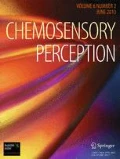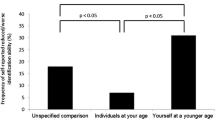Abstract
Large population-based studies using validated olfactory tests have shown that about 20 % of individuals aged 20 to 90 years have impaired olfactory function. The goal of the present study was the development of an easy to administer and reliable questionnaire to assess self-reported olfactory functioning in patients suffering from problems with the sense of smell. A cross-sectional, psychometric study using factor analysis and internal consistency methodology was performed to develop the 12-item questionnaire for the assessment of self-reported olfactory functioning and olfaction-related quality of life (ASOF). Discriminative validity of the three ASOF scales was assessed by comparing healthy controls and patients with problems with the sense of smell. Three hundred and thirteen normal controls with intact olfaction and 35 patients with olfactory dysfunction were included. All subjects included in the study were evaluated for olfactory dysfunction by means of the Sniffin’ Sticks. The ASOF can be subdivided into three domains: the one-item subjective olfactory capability scale (SOC), the five-item self-reported capability of perceiving specific odors scale (SRP), and the six-item olfactory-related quality of life (ORQ) scale. All three scales discriminated significantly between healthy controls and patients. The ASOF measures subjective olfactory functioning reliably and consistently, in normosmic subjects as well as in patients with olfactory dysfunction. The ASOF is a clinically relevant and practical diagnostic tool with very good psychometric properties. This new questionnaire may be helpful in the comprehensive evaluation of patients with olfactory disorders.
Similar content being viewed by others
References
Bahar-Fuchs A, Moss S, Rowe C et al (2011) Awareness of olfactory deficits in healthy aging, amnestic mild cognitive impairment and Alzheimer’s disease. Int Psychogeriatr 23(7):1097–1106. doi:10.1017/s1041610210002371
Bortz J (1993) Statistik für Sozialwissenschaftler. Springer, Berlin
Bramerson A, Johannson L, Ek L et al (2004) Prevalence of olfactory dysfunction: the skovde population-based tudy. Laryngoscope 114:733–737
Croy I, Landis B, Meusel T et al (2011) Patient adjustmet to reduced olfactory function. Arch Otolaryngol Head Neck Surg 137:377–382
Deems DA, Doty RL, Settle RG (1991) Smell and taste disorders, a study of 750 patietns from the University of Pennsylvania Smell and Taste Center. Arch Otol Head Neck Surg 117:519–528
Doty RL (2006) Olfactory dysfunction and its measurement in the clinic and workplace. Int Arch Occup Environ Health 79:268–282. doi:10.1007/s00420-005-0055-6
Doty RL, Shamson P, Dann M (1984) Development of the University of Pennsylvania Smell Identification Test: a standardized microencapsulated test of olfactory function. Physiol Behav 32:489–502
Hoffman HJ, Ishii EK, Macturk RH (1998) Age-related changes in the prevalence of smell/taste problems Among the United States adult population: results of the 1994 disability supplement to the National Health Interview Survey (NHIS). Ann NY Acad Sci 855:717–722
de Jong N, Mulder I, de Graaf C et al (1999) Impaired sensory functioning in elders: the realtion with its potential determinants and nutritional intake. J Gerontol Biol Sci 54A:B324–B331
Kobal G, Hummel T, Sekinger B et al (1996) “Snffin’ Sticks”: screening of olfactory performance. Rhinology 34:222–226
Landis B, Konnerth C, Hummel T (2004) A study on the frequency of olfactory dysfunction. Eur Arch Otolaryngol 11:1764–1769
Lienert GA (1989)Testaufbau und Testanalyse München: Psychologie Verlags Union.
Marschner H, Gudziol H, Guntinas-Lichius O (2010) Olfactory dysfunctions are substantially more frequent than they are complained. Laryngo-Rhino-Otologie 89:654–659. doi:10.1055/s-0030-1262779
Miwa T, Furukawa M, Tsukatani T et al (2001) Impact of olfatory impairment on quality of life and disability. Arch Otolaryng Head Neck Surg 127:497–503
Murphy C, Schubert CG, Cruickskanks KJ et al (2002) Pravalence of olfactory imapriment in older adults. JAMA 288:2307–2312
Neuland C, Bitter T, Marschner H et al (2011) Health-related and specific olfaction-related quality of life in patients with chronic functional anosmia or severe hyposmia. Laryngoscope 121:867–872. doi:10.1002/lary.21387
Schubert CR, Cruickskanks KJ, Klein BEK et al (2011) Olfactory impairment in older adults: five year incidence and risk factors. Laryngoscope 121:873–878
Shu CH, Lee PL, Lan MY et al (2011) Factors affecting the impact of olfactory loss on the quality of life and emotional coping ability. Rhinol 49:337–341. doi:10.4193/Rhino10.130
Temmel AFP, Quint C, Schickinger-Fischer B et al (2002) Characteristics of olfactory disorders in relation to major causes of olfactory loss. Arch Otol Head Neck Surg 128:635–641
Tennen H, Affleck G, Mendola R (1991) Coping with Smell and Taste Disorders. In: Getchell TV, Doty RL, Bartoshuk LM, Snow JB (eds) Smell and taste in health and disease. Raven Press, New York, pp 787–804
Wehling E, Nordin S, Espeseth T et al (2011) Unawareness of olfactory dysfunction and its association with cognitive functioning in middle aged and old adults. Arch Clin Neuropsychol 26:260–269. doi:10.1093/arclin/acr019
Acknowledgments
We thank Peter Walla and Bernd Hufnagl for their support in this study. Matthias Laska and Thomas Hummel made helpful suggestions regarding the manuscript. We would like to thank Arinya Eller and Susannah Revkin for proofreading the manuscript. A German version and an English version of the ASOF are available free of charge from the authors.
Author information
Authors and Affiliations
Corresponding author
Rights and permissions
About this article
Cite this article
Pusswald, G., Auff, E. & Lehrner, J. Development of a Brief Self-Report Inventory to Measure Olfactory Dysfunction and Quality of Life in Patients with Problems with the Sense of Smell. Chem. Percept. 5, 292–299 (2012). https://doi.org/10.1007/s12078-012-9127-7
Received:
Accepted:
Published:
Issue Date:
DOI: https://doi.org/10.1007/s12078-012-9127-7



